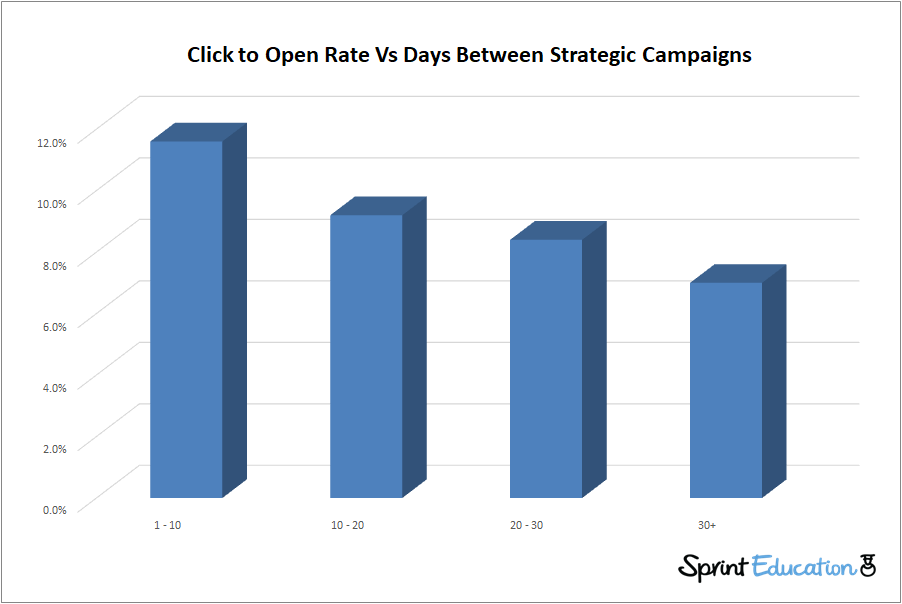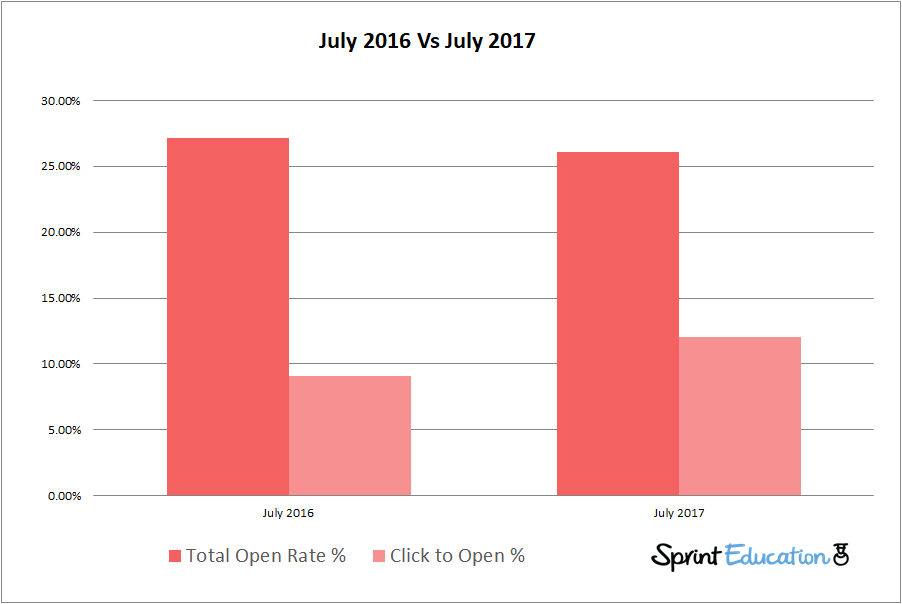Revealed: The Optimum Number of Days Between Your Campaigns
Revealed: The Optimum Number of Days Between Your Campaigns
Welcome to September’s edition of Stu’s Edu News where, among other things, I’ll be revealing the optimum number of days between your emails to teachers.
Welcome to September’s edition of Stu’s Edu News where, among other things, I’ll be revealing the optimum number of days between your emails to teachers.
1) The Optimum Number of Days Between Campaigns
At Sprint Education, we tend to plan our clients' email strategies in mini 'sprints' of 3 campaigns. However, until now, we've never had any cold hard stats about the optimum number of days between each of those 3 emails. The graph below shows that strategies where there was a gap of less than 10 days between each email generated the highest level of engagement. Anything above 10 days and there was a steady drop-off in engagement.

2) July 2016 Vs July 2017
Having been collating all our clients' campaign stats for more than a year now, I thought it would be useful to compare the results of campaigns sent in July 2017 with those of July 2016. In contrast to what you may think, July was the highest performing month in 2016 in terms of open rates. This July, the average open rate actually fell slightly but still generated a mightily impressive average of 26.08%. Click-through rates saw a sharp rise however, with almost a 3% increase on those campaigns sent in the same month last year.

Here’s what’s going on in the Education sector as we enter the new academic year...
A-Levels
This year's A-level results came out last month and saw an increase in grades for the first time in six years for England and Wales schools. Although not a huge rise (0.5%), this year was a victory for the boys and saw them outperform the girls in getting the top grades - the first time this had been achieved for 17 years! Northern Ireland saw a significant rise in A-level performance and saw A Star or A grades being achieved in 30.4% of entries (a rise of 0.9% on 2016).
Several A-level subjects saw a large increase in students picking them up, with politics leading the way alongside computing. In a move that was linked to increased youth engagement after Brexit and the election of Donald Trump, there was a 12.8% rise in the number of students opting for political science.
In spite of A-level grades rising, this year saw a drop in the number of students applying for university. This has largely been put down to the dramatic rise in tuition fees in recent years. Due to the uncertainly surrounding Brexit, the number on non-UK nationals applying for university is also down.
Furthermore, many of the UK’s leading universities have been pushing to introduce their own entrance exams. This comes as more universities are seeking a way of differentiating between high-performing students, with so many now achieving the top grades.
GCSEs
This year saw some GCSE papers in England switch to a scale of 9 to 1, rather than the letters format we are used to. This is to be fully phased in over the next few years and comes as a result of calls from some politicians that too many students were achieving the highest grades.
This year's students are the first to sit exams in the new GCSEs in english (literature and language) and maths. Another 20 subjects will have 9 to 1 grading in 2018, with most others following in 2019.
Here’s how the new system works:
The highest grade is 9, rather than 1 as you might think. This is to allow additional number to be added (10, 11, 12 etc.) should the government feel the system needed to be even more rigorous.
Three number grades (9, 8 and 7) correspond to the current top grades of A Star and A. This is designed to give more differentiation and therefore make it harder to achieve the top grade of 9.
It seems that grade 5 is to be the benchmark for schools, and they will be largely judged based on the number of students who achieve this grade and above.
A tougher exam system has been implemented in Wales also, however their letters structure will remain the same. Currently, there is no change to the systems used in Scotland and Northern Ireland.
Tags
Database of Schools
Email Teachers
Marketing to Schools
Selling to Schools
Similar Articles


Understanding school funding statistics for 2023-2024’s budget
The government have announced school budget figures for 2023-2024. Get the details, and secure your share of the £57.3 billion.


Now Available: 185,000 International School Contacts
Sprint Education are pleased to announce the latest milestone on our journey toward building the largest and most powerful education database.


Expert marketing to schools support and solutions
Expert marketing to schools solutions
Email Head Teachers, Teachers, and Staff Inboxes
Email teachers and staff inboxes
Sell More to UK and Global Schools and Colleges
Sell more to schools and colleges

































